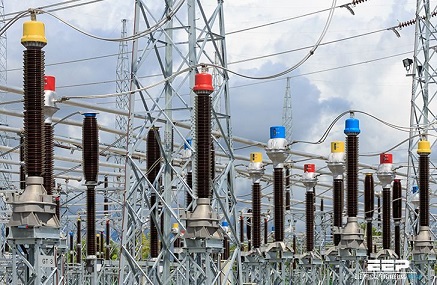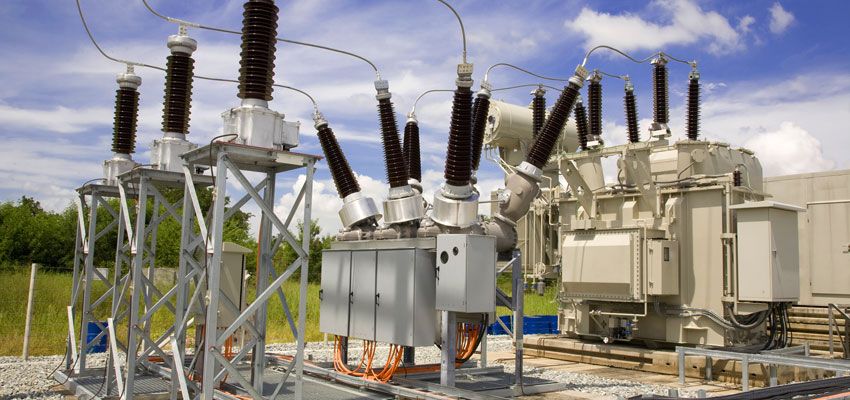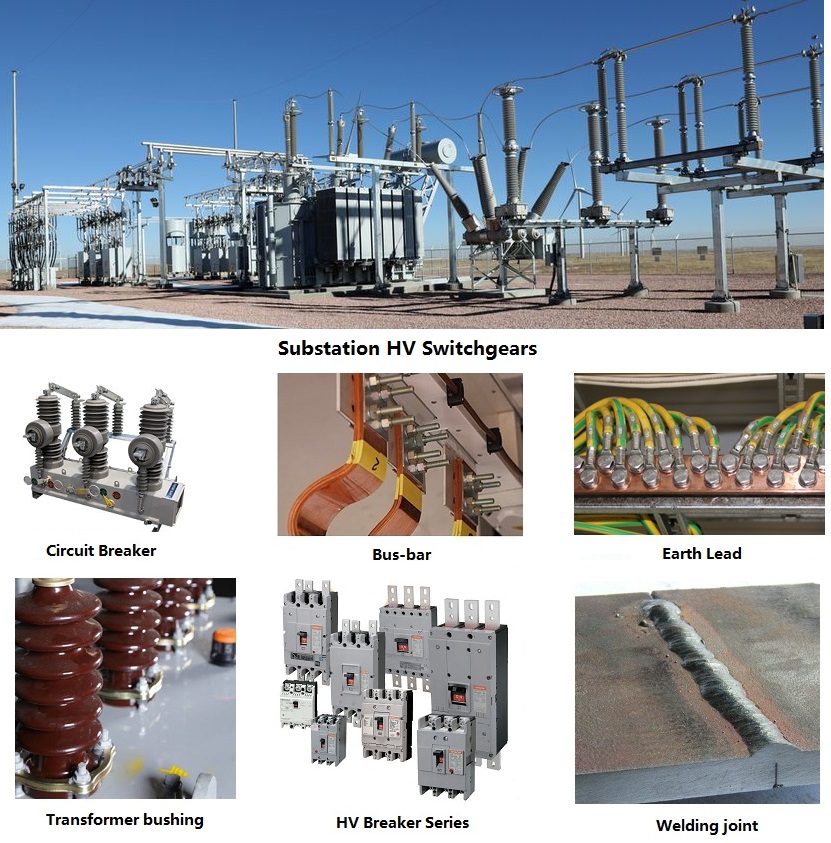What are the functions of substation equipments?
1. What are the main components of oil-immersed transformers?
Answer: The main components of the transformer are: iron core, winding, fuel tank, oil pillow, respirator, explosion-proof pipe, radiator, insulating sleeve, tap changer, gas relay, thermometer, net oil, etc.
2. What is a fully insulated transformer? What is a semi-insulating transformer?
Answer: Semi-insulation is the main insulation of the winding near the neutral point of the transformer, and its insulation level is lower than that of the end windings. On the contrary, generally the insulation level of the transformer head and tail windings is called full insulation.
3. What is the main function of the transformer in the power system?
Answer: The role of the transformer in the power system is to transform the voltage to facilitate the transmission of power. After the voltage is boosted by the step-up transformer, the line loss can be reduced, the economy of power transmission can be improved, and the purpose of long-distance power transmission can be achieved. The step-down transformer can change the high voltage into the voltage required by the user at all levels to meet the needs of the user.
4. What are the hazards of casing cracks?
Answer: Cracks in the casing will reduce the insulation strength, which can cause further damage to the insulation until all breakdowns. The casing may also burst when the water in the fracture freezes. It can be seen that the casing crack is very threatening to the safe operation of the transformer.
5. What is the difference between neutral point and zero point and zero line?
Answer: The common connection point where the heads (or tails) of the three-phase windings are connected together is called the neutral point of the power supply. When the neutral point of the power supply has a good connection with the grounding device, the neutral point is called the zero point; and the wire drawn from the zero point is called the neutral line.
6. Why is the outdoor busbar connector easy to heat?
A: Outdoor busbars are often eroded by wind, rain, snow, sunlight, and freezing. All of these can promote the accelerated oxidation and corrosion of the busbar joints, so that the contact resistance of the joints increases and the temperature rises.
7. What are the chemical properties of SF6 gas?
Answer: SF6 gas is insoluble in water and transformer oil, and it does not interact with oxygen, argon, aluminum and many other substances at hot temperatures. However, under the action of arc and corona, SF6 gas will decompose to produce low-fluorine compounds, which can cause damage to insulating materials, and these low-fluorine compounds are highly toxic gases. The decomposition reaction of SF6 has a lot to do with moisture, so dehumidification measures should be taken.
8. What is the function of the oil pillow of the transformer?
Answer: When the volume of transformer oil expands or shrinks with the change of oil temperature, the oil pillow plays the role of oil storage and oil replenishment, which can ensure that the oil tank is full of oil. reduced, slowing down the rate of oil deterioration. There is also an oil level gauge on the side of the oil pillow, which can monitor changes in oil level.
9. Why should the iron core of the transformer be grounded?
Answer: The iron core and other accessories of the transformer are in the electric field around the winding during operation. If they are not grounded, the iron core and other accessories will inevitably induce a certain voltage. Under the action of the applied voltage, when the induced voltage exceeds the ground discharge voltage , a discharge phenomenon will occur. In order to avoid the internal discharge of the transformer, the iron core should be grounded.

10. Why install a set of ZnO arresters between the power capacitor and its circuit breaker?
Answer: The installation of ZnO arrester can prevent the operation overvoltage that may occur when the power capacitor is pulled and closed, and ensure the safe operation of electrical equipment.
11. What is the difference between the values indicated by the electric energy meter and the power meter?
Answer: The power meter indicates the amount of electric power issued, transmitted and consumed by the instantaneous generation, supply and consumption equipment; and the value of the electric energy meter is the cumulative amount of electric energy issued, transmitted and consumed within a certain period of time.
12. What are the requirements for batteries in parallel battery packs?
Answer: The electromotive force of each battery in the parallel battery should be equal, otherwise the battery with large electromotive force will discharge the battery with small electromotive force, forming a circulating current inside the battery pack. In addition, the internal resistance of each battery should also be the same, otherwise the discharge current of the battery with small internal resistance will be too large. Batteries with different degrees of old and new should not be used in parallel.
13. What is the function of the central signal device?
Answer: The central signal is a signal device that monitors the operation of the electrical equipment in the substation. It sends out sound and light signals according to the fault characteristics of the electrical equipment, informing the operators to search quickly, make correct judgments and deal with them, and ensure the safe operation of the equipment.
14. Why does electricity still exist in a short period of time when the electric test pen is used for electricity inspection after the power failure of the cable line?
Answer: The cable line is equivalent to a capacitor. After a power failure, there is still residual charge in the line, and there is still a potential difference to the ground. If the power is cut off immediately, the test pen will show that there is electricity on the line. Therefore, it must be fully discharged, and the grounding wire can be installed only after the electricity is tested without electricity.
15. What is internal overvoltage?
Answer: Internal overvoltage is a transitional process in which the state of the system changes suddenly due to operation, accident or other reasons, and there will be a transition process from one stable state to another stable state. During this process, there may be dangerous overvoltages to the system. . These overvoltages are caused by the oscillation and accumulation of electromagnetic energy in the system, so they are called internal overvoltages.
16. What is the function of the upper equalizing ring of the 220kV valve arrester?
Answer: After installing the voltage equalizing ring, make the voltage distribution of the arrester even.
17. What is protection zero connection? What are the advantages?
Answer: The protection zero connection is a way to directly connect the metal parts of the equipment that are not charged under normal conditions to the system with wires. Take the protection zero method to ensure personal safety and prevent electric shock accidents.
18. What is the function of high voltage circuit breaker?
Answer: The high-voltage circuit breaker can not only cut off and connect the no-load current and load current in the high-voltage circuit under normal conditions, but also cooperate with the protection device and automatic device when the system fails to quickly cut off the fault current and prevent the accident from expanding. Ensure the safe operation of the system.
19. What role does the DC system play in the substation?
Answer: The DC system provides reliable DC power for control, signal, relay protection, automatic device and emergency lighting in the substation. It also provides reliable operating power for operation. Whether the DC system is reliable or not plays a vital role in the safe operation of the substation and is the guarantee for the safe operation of the substation.
 20. In order to keep the battery in a fully charged state during normal float charging, what should be the terminal voltage of each battery?
Answer: In order to keep the battery in a fully charged state, each battery connected to the DC bus must maintain a voltage of 2.15V during float charging.
21. Why install a DC insulation monitoring device?
Answer: Long-term operation of one pole grounded in the DC system of the substation is not allowed, because if the grounding occurs again at another point of the same pole, it may cause malfunction of the signal device, relay protection and control circuit. In addition, when one pole is grounded, if the other pole is grounded again, it will cause a DC short circuit.
22. Explain what is floating charge?
Answer: Floating charging is installed in two charging units, one is the main charging unit and the other is the floating charging unit. Float charging is to compensate for the self-discharge loss of the battery, so that the battery pack is always in a fully charged state.
23. What is the function of the wave trap?
Answer: The wave choke is an indispensable high-frequency communication component for carrier communication and high-frequency protection. It prevents the leakage of high-frequency current to other branches and reduces high-frequency energy loss.
24. What are the phenomena when the system oscillates?
Answer: The phenomena when the system oscillates are:
(1) The pointers of the current, voltmeter and power meter in the substation swing periodically. If there is a tie line, the swing of the meter is the most obvious.
(2) The closer it is to the oscillation center of the system, the greater the voltage swing, and the flickering of the incandescent lamp is very obvious.
25. What is the function of the dropped card not reset signal?
Answer: The lost card has not been reset to the light signal, so that the on-duty personnel will not miss omissions and cause misjudgment in the process of recording the protection action. Attention should be paid to returning the signal to the lost card in time to avoid repeated actions, so that the two before and after cannot be distinguished. .
26. Can low-voltage AC and DC circuits share a single cable, and why?
Answer: No, because:
(1) Sharing a single cable can reduce the insulation level of the DC system.
(2) If the DC insulation is damaged, the DC mixed line will cause a short circuit or malfunction of the relay protection.
27. What size of megger should be used to measure the insulation of the secondary circuit? How many megohms is the insulation standard?
Answer: It is best to use a 1000V megohmmeter to measure the insulation resistance value of the secondary circuit. If there is no 1000V megohmmeter, a 500V megohmmeter can also be used. Its insulation standard: no less than 1 megohm in operation, no less than 20 megohm indoors, and no less than 10 megohm outdoors.
28. What are the uses of the auxiliary contacts of the oil switch?
Answer: The normally open and normally closed contacts of the oil circuit breaker itself change the opening and closing positions to connect the closing and tripping circuits of the circuit breaker mechanism and the sound signal circuit, so as to achieve the purpose of opening or closing the circuit of the circuit breaker, and can correctly Send out an audible signal, start the automatic device and protect the blocking circuit, etc. When the auxiliary contacts of the circuit breaker are used in the closing and tripping circuits, there should be time delays.
29. What is the function of current transformer?
Answer: The current transformer converts the large current into a small current in a certain proportion, provides current for various instrumentation and relay protection, and isolates the secondary system from high voltage. It not only ensures the safety of people and equipment, but also simplifies and standardizes the manufacture of instruments and relays, and improves economic benefits.
30. What is the working principle of overcurrent protection?
20. In order to keep the battery in a fully charged state during normal float charging, what should be the terminal voltage of each battery?
Answer: In order to keep the battery in a fully charged state, each battery connected to the DC bus must maintain a voltage of 2.15V during float charging.
21. Why install a DC insulation monitoring device?
Answer: Long-term operation of one pole grounded in the DC system of the substation is not allowed, because if the grounding occurs again at another point of the same pole, it may cause malfunction of the signal device, relay protection and control circuit. In addition, when one pole is grounded, if the other pole is grounded again, it will cause a DC short circuit.
22. Explain what is floating charge?
Answer: Floating charging is installed in two charging units, one is the main charging unit and the other is the floating charging unit. Float charging is to compensate for the self-discharge loss of the battery, so that the battery pack is always in a fully charged state.
23. What is the function of the wave trap?
Answer: The wave choke is an indispensable high-frequency communication component for carrier communication and high-frequency protection. It prevents the leakage of high-frequency current to other branches and reduces high-frequency energy loss.
24. What are the phenomena when the system oscillates?
Answer: The phenomena when the system oscillates are:
(1) The pointers of the current, voltmeter and power meter in the substation swing periodically. If there is a tie line, the swing of the meter is the most obvious.
(2) The closer it is to the oscillation center of the system, the greater the voltage swing, and the flickering of the incandescent lamp is very obvious.
25. What is the function of the dropped card not reset signal?
Answer: The lost card has not been reset to the light signal, so that the on-duty personnel will not miss omissions and cause misjudgment in the process of recording the protection action. Attention should be paid to returning the signal to the lost card in time to avoid repeated actions, so that the two before and after cannot be distinguished. .
26. Can low-voltage AC and DC circuits share a single cable, and why?
Answer: No, because:
(1) Sharing a single cable can reduce the insulation level of the DC system.
(2) If the DC insulation is damaged, the DC mixed line will cause a short circuit or malfunction of the relay protection.
27. What size of megger should be used to measure the insulation of the secondary circuit? How many megohms is the insulation standard?
Answer: It is best to use a 1000V megohmmeter to measure the insulation resistance value of the secondary circuit. If there is no 1000V megohmmeter, a 500V megohmmeter can also be used. Its insulation standard: no less than 1 megohm in operation, no less than 20 megohm indoors, and no less than 10 megohm outdoors.
28. What are the uses of the auxiliary contacts of the oil switch?
Answer: The normally open and normally closed contacts of the oil circuit breaker itself change the opening and closing positions to connect the closing and tripping circuits of the circuit breaker mechanism and the sound signal circuit, so as to achieve the purpose of opening or closing the circuit of the circuit breaker, and can correctly Send out an audible signal, start the automatic device and protect the blocking circuit, etc. When the auxiliary contacts of the circuit breaker are used in the closing and tripping circuits, there should be time delays.
29. What is the function of current transformer?
Answer: The current transformer converts the large current into a small current in a certain proportion, provides current for various instrumentation and relay protection, and isolates the secondary system from high voltage. It not only ensures the safety of people and equipment, but also simplifies and standardizes the manufacture of instruments and relays, and improves economic benefits.
30. What is the working principle of overcurrent protection?
Answer: When a phase-to-phase short-circuit fault occurs in the power grid, the current will suddenly increase and the voltage will suddenly drop. The overcurrent protection is to set the operating current of the current relay according to the requirements of line selectivity. When the fault current in the line reaches the action value of the current relay, the action of the current relay selectively cuts off the fault line according to the selective requirements of the protection device.
Kingrun Transformer Instrument Co.,Ltd.


More Transformer Testers from Kingrun



Related Articles:
What Test Items are Required for 110kV/220kV Substation Acceptance and Maintenance Testing?
What Tests Must be Done before the Transformer Leaves the Factory?
Main Factors Affecting the Operating Life of Transformers
What is the Purpose of Measuring the DC Resistance of the Transformer Winding?
Points to note in transformer oil breakdown voltage (BDV) test
DC winding resistance tester with 500 times tests on a single charge -JYR9310





